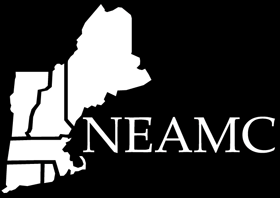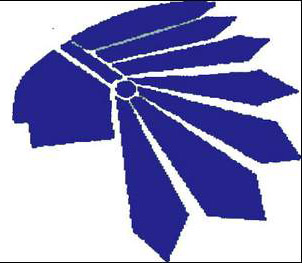

Sunday, April 20, 2008
"Generic Indian likenesses"
By Pete Sanfaçon
NEW ENGLAND ANTI-MASCOT COALITION
On April 9, 2008, the Wilton-Lyndeborough Cooperative School Board voted not to change the "Warriors" logo at the local high school. On April 18 Tony Lynch (school board chairman) posted details of the decision on the WLC Matters blog.
Wilton WarriorThe Wilton Warrior has been a topic of conversation since the WLC School Board received a letter of complaint last year. The author of that letter, a former New Hampshire resident, expressed his belief that Wilton-Lyndeborough Cooperative School's identification with the team name "Warriors" and our logo are offensive and should be stopped. The author said all Indian mascots are objectionable, and provided supporting opinions from several groups, including the New Hampshire State Board of Education. That board, which oversees the N.H. Department of Education, passed a resolution in 2002 critical of Indian mascots. It was the state board of education's opinion that: "The use of Native American symbols as mascots [has a] detrimental affect on the achievement, education, self-concept and self-esteem of American Indian students and sends an improper message to everyone of the true meaning and spirit of being of American Indian heritage." And its resolution said "it is important to be culturally sensitive and to educate everyone working within the New Hampshire School Education System, that no matter how well meaning their intentions, that their actions may be offensive and harmful to some and therefore, need to be eliminated." Our board asked for some clarification on that opinion. Commissioner of Education Lyonel B. Tracy noted in response that the resolution is non-binding, calls on districts to examine the issue and acknowledges that the selection of school mascots is a local decision. This board also heard the results of a school survey and from several members and former members of the community, a few with Indian ancestry. While some people identified specific sports logos and professional sports mascots as clearly offensive, no one in our community found our Warrior to be disrespectful. |
The school survey simply asked if using the WLC warrior as the school logo is offensive. It did not reference the 2002 resolution by the N.H. Board of Education, which called for all school districts to "examine this issue and to eliminate the use of sports mascots." This survey simply served as an opportunity for students to express their feelings of school pride.
 |
 |
|
We learned the name "Warrior" was taken by Wilton many years ago, at a time when schools commonly adopted Indian team names, and that it could have been as much an attempt to be alliterative as to honor or respect native Americans. Many towns use the "Warrior" name, including Wilton High School in Wilton, Conn. We learned that the logo now in use has an uncanny resemblance to that of the former Indian Head National Bank, which had a branch in Wilton. Yet however it began, the Warrior name is deeply rooted in local history and affection. |
The use of the "Warriors" nickname is not an issue, but when it is coupled with a stereotypical "Plains Indian" logo, the issue becomes a serious problem at an all-white school. Are there no white people that white citizens can be proud of?
 |
 |
|
After considering all the information, the WLC School Board publicly states the following: 1) WLC respects all individuals. The school and school board does not and will not tolerate disrespect based on identification with a group, racial, ethnic or otherwise. This is board policy and, of course, common decency. |
The school board has demonstrated rather unequivocally that it DOES "tolerate disrespect based on identification with a group, racial, ethnic or otherwise." They've sanctioned a racial stereotype as the official logo at the school, plainly contradicting their very own policy.
 |
 |
|
2) The WLC School Board board believes the correct test of what is offensive is not whether a single person is offended. Such a low threshold is unreasonable and would eventually become unworkable. We set the bar instead at a community standard, whether an average person could reasonably find our name or Warrior logo offensive when judged against generally accepted standards of decency. |
The "single person" is a reference to me and the work of the New England Anti-Mascot Coalition. Our work is supported by American Indian Sports Team Mascots, Students and Teachers Against Racism, United American Indians of New England, Seacoast Branch NAACP (Portsmouth, NH), Oklahoma Indian Alliance, Gedakina, Inc., Native Earth Education Project (Mass.), and Honor Indians Institute. Our efforts throughout New England are supported by the resolutions published by the U.S. Commission on Civil Rights, the NAACP, the National Congress of American Indians, the Massachusetts Commission on Indian Affairs, and the Massachusetts Center for Native American Awareness. More than "a single person" is offended.
 |
 |
|
Acknowledging the State Board of Education's concern about sports mascots, and agreeing with that board that the matter is one for local control, we find the Wilton Warrior logo does not cross this line and should not be changed. |
The "line" that the Warrior logo "does not cross" must not have anything to do with racial stereotypes. If it did, this logo most certainly WOULD "cross this line."
 |
 |
|
To further clarify its opinion, the WLC school board has drafted the following statement to be added into the student handbook. The Wilton Warrior logo is the picture that identifies WLC to the community. As such, it should be treated with as much respect as the school. When used in connection with school events, functions or publications, the Wilton Warrior logo should not be altered, caricatured, or substituted for a generic Indian likeness or theme. |
The Wilton Warrior logo is by definition a "generic Indian likeness." No one in the community finds it offensive, so it stays. End of discussion. According to the N.H. Department of Education, the WLC school district in 2006-07 had no American Indians enrolled out of 386 students. Enrollment is actually 92% white in a state that is 96% white, with just 3,000 Indians statewide (according to U.S. Census data). It is unlikely that a large number of American Indians who feel offended or stereotyped will come forward when their numbers are so small. In the U.S. American Indians account for less than 1% of the total population.
 |
 |
|
What I hoped would be taken away from the statement was that the complaint was taken seriously, because it had the backing of the State Board of Education. In the end we found some people offended by the idea of having an Indian mascot, but we heard from only one person who said he was offended by the actual Warrior logo. (We also heard from several local residents of Indian ancestry who were offended that the board was considering making the change.) |
The complaint was taken seriously, yet it was ultimately ignored in favor of the status quo. The school's own mission statement expects its students to "Understand and respect diverse cultures." How can this be if the school board has sanctioned a race-based policy for the high school? Nice work. Way to teach respect and understanding for diverse cultures.
The work of the New England Anti-Mascot Coalition throughout New England—including WLC—will continue.
ps 4.20.08
[Complete text of my blog correspondence with WLC School Board Chairman Tony Lynch]
 |
 |